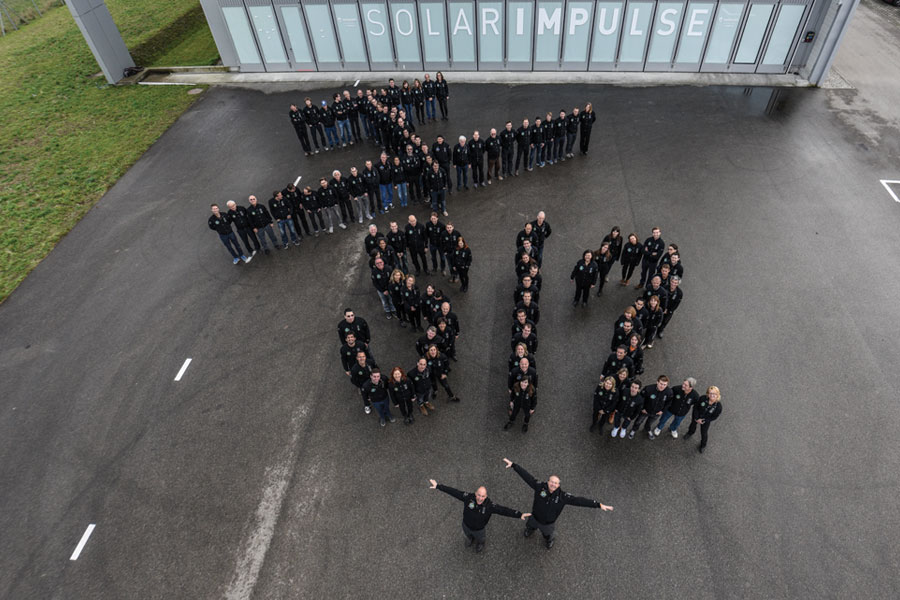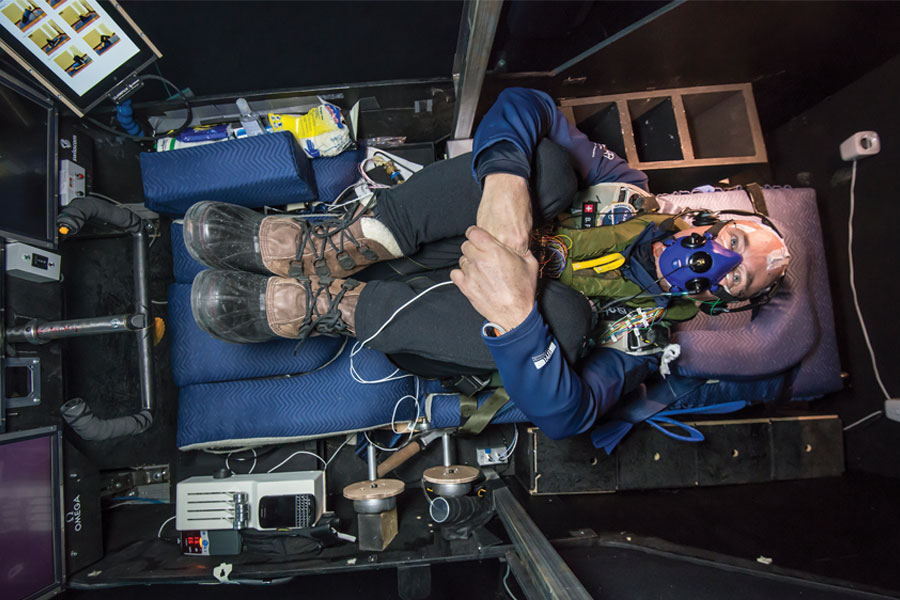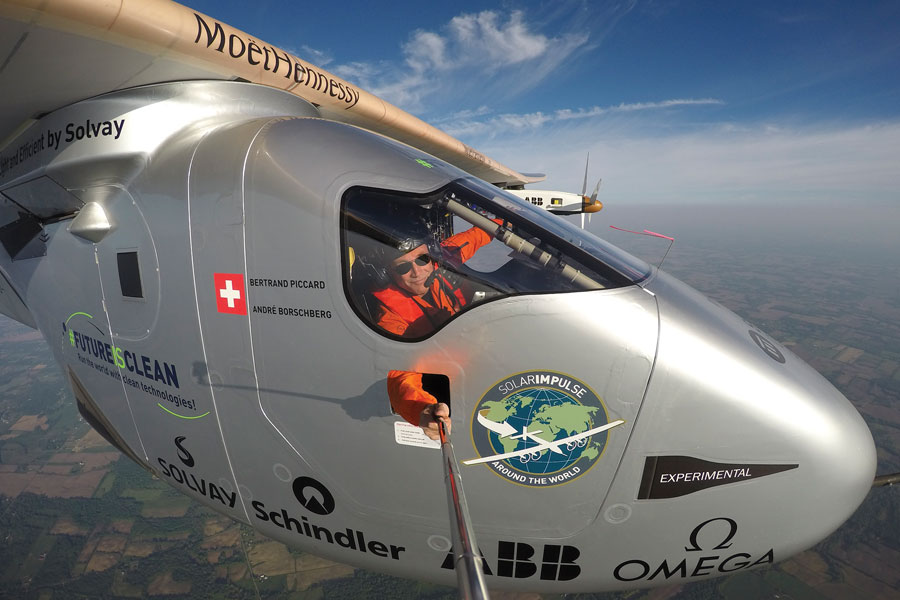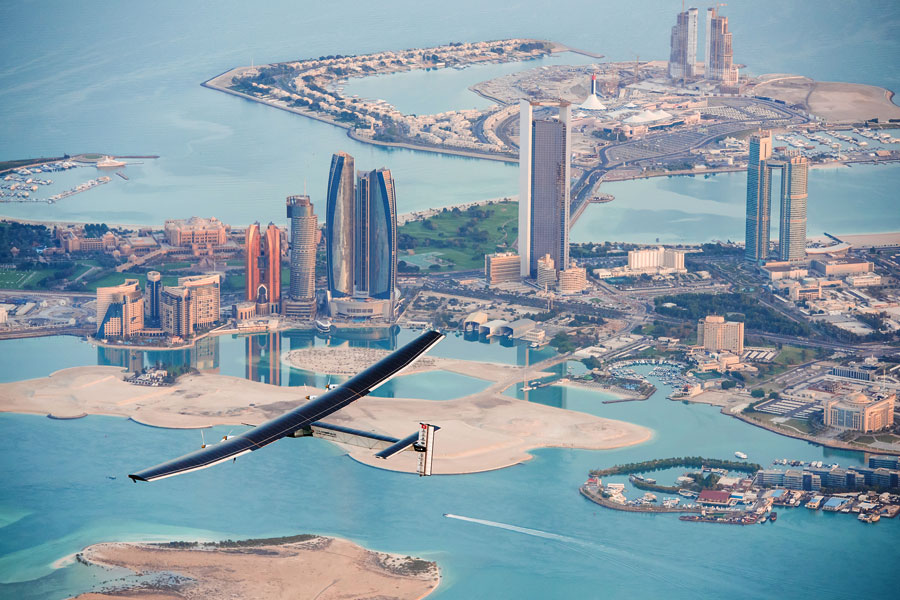In silence, and without using a drop of fuel, two visionary pilots embark on the world’s first circumnavigation using only the power of the sun
It was the Wright brothers all over again. On 3 December 2009 at Dübendorf Airfield in Switzerland, 106 years after the first powered flight by Orville and Wilbur Wright on a beach at Kitty Hawk, North Carolina, USA, a group of aviation fanatics flew the world’s first solar powered airplane. The skeletal-looking prototype, named Solar Impulse, gently rose into the air and flew 40 inches above the ground for a distance of 0.2 miles, landing to wild cheers from the assembled team.

With today’s aircraft reaching heights of 85,000 feet and speeds of over 2,000 miles per hour, you may ask: why the big deal? After all, that first flight back in 1903 managed to fly 10 feet above the ground.
I had a dream of a solar aircraft capable of flying day and night without fuel – and promoting renewable energy.
For a start, Solar Impulse doesn’t use a drop of fuel. And like most prototypes the innovative technology’s potential uses and future applications are hugely exciting. Bertrand Piccard, president of Solar Impulse, had a vision of reinventing flight – or “inventing the future,” as he likes to call it.
“I had a dream of a solar aircraft capable of flying day and night without fuel – and promoting renewable energy,” he explains. After six years of intense research, he proved the technology existed with the first “flea hop” across the Swiss airfield, but to demonstrate this may indeed be our future, he needed something bolder. Along with co-founder Andre Borschberg, Piccard dreamed up an audacious plan – the first around-the-world flight powered by the sun. This was achieved on 26 July 2016, when the Si2 landed in Abu Dhabi in the United Arab Emirates, after a total of 23 days flight.

The 22,000-mile journey was broken up into 17 stages, to allow for the technical limitations of the new technology and the physical limits of the pilots. No sleep was permitted while the plane was flying over populated areas, but over oceans sleep was in the form of short naps of up to 20 minutes, 12 times a day.
The Swiss pioneers were acutely aware of the historical significance of their journey, and the ironic symbolism along the way. On the Hawaii to North America leg – a journey similar to the one flown by 1930s American aviator Amelia Earhart, the pair drew a parallel between Earhart’s airplane that carried 500 gallons of gasoline, and theirs that carried none. Across the main wing of their plane, 17,248 solar cells powered four lithium batteries, which in turn powered four motors and propellers, allowing Si2 to fly through the night until dawn.

The idea of traditionally-powered mobility has just been turned on its head. “Just imagine your energy reserves increasing during flight!” says Borschberg. It’s almost incomprehensible that a journey would gain fuel, rather than consume it.
Solar Impulse’s goal is to demonstrate that clean technologies, such as the ones used on the Solar Impulse airplane, have the potential to change lives, societies and future markets in an unprecedented way. They have shown that solutions actually do exist, now, to run the world on clean technologies.“If an airplane can fly day and night without fuel, everybody could use these same technologies on the ground to halve our world’s energy consumption,” says Piccard.
“This will save natural resources and improve our quality of life. Our hope is to motivate everyone to reduce their dependence on fossil fuels in their daily lives and thus encourage concrete actions for sustainability.”
Piccard is promoting the use of new, modern and clean technologies as an opportunity for change and wants to influence the energy decisions taken within political, economic and social systems. His message conveys a visionary approach: solving climate change is not an expensive problem, but rather a unique opportunity for profit and job creation. “Climate change, and in particular carbon dioxide emissions, are mainly caused by inefficient energy sources,” he says. “If those outdated technologies were to be replaced with modern technologies, the energy consumption of the world, and therefore the C02 emissions, could be halved. We’ve shown that solving climate change is a profitable opportunity, not an expensive problem.”
Climate change, and in particular carbon dioxide emissions, are mainly caused by inefficient energy sources.
Key to the success of this project has been the different, yet complimentary, personalities of the two adventurers. Piccard is a medical doctor, explorer and lecturer; Borschberg is an engineer. What they have in common is a love for innovation and the future health of our planet.

“This is not only a first in the history of aviation,” states Piccard. “It’s also a first in the history of energy. I’m sure that within 10 years we’ll see electric airplanes transporting 50 passengers on short- to medium-haul flights.” Piccard’s grandfather, Auguste, was the first man to see the curvature of the Earth from the stratosphere, in a hot air balloon. It gave him a new perspective on life: “The question now is not so much whether humans can go even further afield and populate other planets, but rather how to organize things so that life on Earth becomes more worthy of living,” his grandfather said in 1931.
Ultimately, people need inspired success stories to change their ways. Piccard and Borschberg have put dreams and emotions back at the heart of scientific adventure.
“Ordinary people, who get excited about great adventures, are ready to join the dreams of pioneers and explorers,” says Borschberg.




































